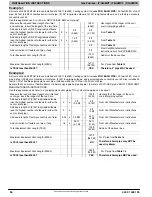
INSTALLATION INSTRUCTIONS
Gas Furnace: (F/G)9MVT, (F/G)9MXT, (F/G)9MXE
44
440 01 4001 05
Specifications subject to change without notice.
Trap Kit, refer to those instructions for proper drain
connections.
The tee may also be connected to the intake air pipe on the
side of the casing. See
Figure 51
.
In any configuration, it will be necessary to add the equivalent
length of the tee (15 feet/5 M) to the Total Equivalent Vent
Length of the venting system.
NOTICE
ADDITIONAL INFORMATION FOR POLYPROPYL-
ENE VENTING SYSTEMS
Polypropylene venting systems include flexible vent
pipe. These flexible vent pipes have a different equi-
valent vent length than straight sections of PVC/ABS
DWV vent pipe. Be sure to make the appropriate de-
ductions from the Maximum Equivalent Vent Length
(MEVL), or additions to the Total Equivalent Vent
Length (TEVL), when applying flexible vent pipes in
polypropylene venting systems. See the polypropylene
vent system manufacturer’s installation instructions for
details.
When using metric-sized venting systems, use these
equivalencies for obtaining the proper MEVL from the
Tables:
Use 2” Vent Tables for 60mm (o.d.) vent systems
Use 3” Vent Tables for 80mm (o.d.) vent systems
Use 4” Vent Tables for 100mm (o.d.) vent systems
The measured length of pipe used in a single or 2
−
pipe
termination is included in the total vent length. Include
deductions from the Maximum Equivalent Vent Length (MEVL)
contained in the Venting Tables for elbows and flexible vent
pipe. Factory accessory concentric vent terminations, or pipe
lengths and elbows used for “standard” vent terminations (see
vent termination figures associated with
Table 14
) do not
require a deduction from the Maximum Equivalent Vent Length.
Include a deduction for a Tee when used for Alberta and
Saskatchewan terminations.
NOTE
: Polypropylene venting systems MAY require additional
deductions from the MEVL, or additions to the TEVL, for vent
terminations and flexible pipe sections. See the polypropylene
venting system manufacturer’s instructions for details on
equivalent lengths of vent terminations and flexible vent pipes,
and for calculating total vent lengths.
To calculate the Total Equivalent Vent Length (TEVL) of the
venting system:
1. Measure the individual distance from the furnace to the
termination for each pipe.
2. Count the number of elbows for each pipe.
3. For each pipe, multiply the number of elbows by the
equivalent length for the type of elbow used. Record the
equivalent length of all the elbows for each pipe.
4. If a Tee is used on the termination (Alberta and
Saskatchewan, when required), record the equivalent
length of the Tee used.
5. Calculate Total Equivalent Vent Length by adding the
equivalent lengths of the fittings to the lengths of the
individual vent and combustion air pipes.
6. When using polypropylene venting systems with flexible
vent pipes, perform adjustments for the equivalent length
of the flexible vent pipe to the calculated total equivalent
venting system length. See the polypropylene vent
system manufacturer’s instructions for details.
7. Select a diameter of vent pipe from
Table 14
and
Table 16
and note the Maximum Equivalent Vent Length
(MEVL) shown for that application for that specific
furnace input size. Compare the Total Equivalent Vent
Length (TEVL) to the MEVL:
a. If the Total Equivalent Vent Length is
shorter
than the
Maximum Equivalent Vent Length for the diameter of
pipe chosen, then that diameter of pipe selected may
be used.
b. If the Total Vent Length is
longer
than the Maximum
Equivalent Vent Length for the diameter of pipe
chosen, that diameter pipe MAY NOT be used for
venting the furnace. Try the next larger diameter pipe.
NOTE
: If the calculated Total Equivalent Vent Lengths results
in different diameter pipes for the vent and combustion air,
select the larger diameter for both pipes.
NOTE
: If the Maximum Vent Length for diameter of the pipe
selected is longer than the measured length and the equivalent
length of all the fittings and terminations (TEVL), recalculate
Total Equivalent Vent Length using the next smaller diameter. If
the Maximum Vent Length is still longer than the longer TEVL
of the vent pipe or combustion air pipe, then that diameter of
pipe selected may be used.
When installing vent systems with pipe lengths of 10 ft. (3.0 M)
or less, use the smallest allowable pipe diameter. Using pipe
size greater than required for short venting systems may result
in loss of efficiency, incomplete combustion, flame disturbance,
or flame sense lockout.
For vent systems longer than 10 ft. (3.0 M), any larger diameter
shown in
Table 14
or
Table 16
for that size model may be
used.
















































